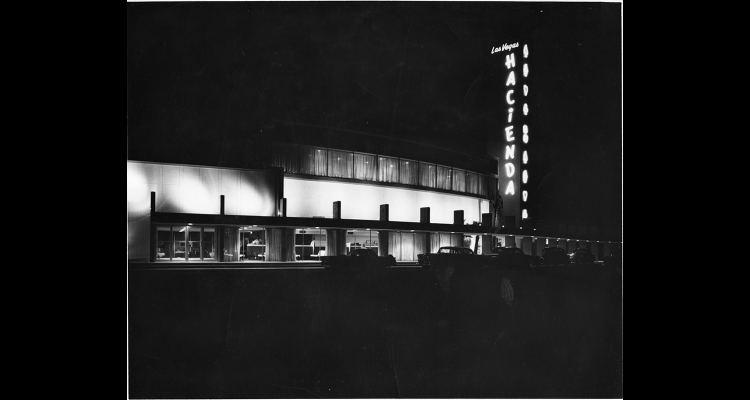Hacienda Hotel
By the mid-1950s, Warren "Doc" Bayley, a former travel writer and one-time farmer from Wisconsin, owned a small but profitable chain of motels under the name Hacienda in California. Bayley used a model unusual for the cut-rate motel room business, providing his patrons—mostly traveling motorists—with things like room service and bellhops. During the resort-building boom in Las Vegas, Bayley decided to try a similar approach on the Strip, this time adding a casino to the mix.
But unlike flashy Strip casino competitors like the Flamingo and Riviera hotels, Bayley did not design the Hacienda to cater to high-rolling gamblers expecting top-name (and expensive) live entertainment. His guest rooms, casino games, restaurants, and other attractions would be directed toward economy-minded travelers and those who bought their children along.
In 1955, Bayley and three partners started building the Hacienda hotel and casino on the far southern end of Las Vegas Boulevard, in an isolated area about a mile from the Flamingo.
The Hacienda's showroom and restaurants were modest by Strip standards. Bayley would install swimming pools and landscaping in between the front casino building and the low-rise rear wings housing guest rooms. To keep the children occupied while their parents gambled, Bayley added kid-friendly activities such as miniature golf and a midget racetrack for go-carts.
Bayley completed the hotel section of the Hacienda in mid-1956.
But his bid to open a casino stalled when the Nevada Gaming Control Board refused to grant a gaming license to Jake Kozloff, an experienced gambler who had invested in the Hacienda and whom Bayley had chosen as casino manager. Board Chairman Robbins Cahill, in opposing Kozloff, cited evidence tying him to organized crime figures in the past. The controversy lasted for months until Bayley agreed to replace Kozloff. The Hacienda's casino finally opened in early 1957.
Bayley developed a unique, and ultimately successful, marketing campaign to propel visitors to the Hacienda. He placed billboards in the cities of Victorville and Barstow, California, popular resting stops along the Los Angeles Highway, the main route used by Southern Californians to Las Vegas. The boards advertised what Bayley dubbed the "Hacienda Holiday," where for $16 customers received a room at the Las Vegas hotel, complimentary food, a bottle of cheap California sparkling wine, and $10 worth of casino credit. Bayley also got gas station attendants in California to distribute printed coupons for stays at the Hacienda. He sent small paychecks to the attendants whose numbered coupons were redeemed at the hotel. The hotel's low-cost approach prompted Las Vegas locals to nickname the Hacienda "Hayseed Heaven."
Efforts to promote the Hacienda reached higher in the early 1960s. For $2 million, Bayley bought a fleet of eight small passenger airplanes that carried "package deal" customers to Las Vegas from New York, Chicago, St. Louis, Los Angeles, and San Francisco. Costumed musicians, a piano bar and even a strip tease performer could be seen on board during flights from Los Angeles. In 1962 alone, Bayley's planes flew in 150,000 people.
In the early 1960s, after Bayley's death, his wife, Judy Bayley, who had participated in running the Hacienda with her husband, took over managing the hotel.
After Bayley died in 1971, her estate sold the Hacienda to California real estate investor Allen Glick. Under Glick, the hotel bought eighty adjacent acres and laid plans for a major expansion. But Glick's Argent Corporation, which also owned the Stardust and Fremont, was accused in 1977 of aiding organized crime in skimming casino proceeds through the efforts of casino boss Frank "Lefty" Rosenthal. The Nevada Gaming Control Board later forced Glick (who denied wrongdoing and was never charged with a crime) and Argent out of the state's gaming business.
Paul Lowden, a one-time Strip casino bandleader who had earlier purchased a fifteen percent share in the Hacienda, assembled enough funds to acquire the Hacienda from Argent in 1979, while also buying the Sahara hotel at the Strip's northern end.
As the number of tourists visiting the Strip grew in the 1970s and 1980s, the Hacienda remained the only large resort on the Strip's far southern side. In the early 1980s, Lowden added 300 hotel rooms, with more on the way. By the early 1990s, the Hacienda was one of the largest hotels in Las Vegas, with 1,100 rooms. The property served as the home of the Little Chapel of the West, a popular site for discount weddings.
Lowden for a time considered converting the Hacienda's rooms into timeshare properties, but he sold the hotel-casino to Circus Circus Enterprises in 1995. The company, later called Mandalay Resort Group, imploded the Hacienda's building in late 1996 to make way for a new resort, the Mandalay Bay hotel.
Article Locations
Related Articles
None at this time.
Further Reading
None at this time.



